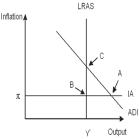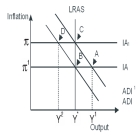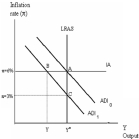Exam 12: The Production Function Approach to Understanding Growth
Exam 1: Measuring Macroeconomic Performance: Output and Prices202 Questions
Exam 2: Measuring Macroeconomic Performance: Saving and Wealth139 Questions
Exam 3: Measuring Macroeconomic Performance: Wages, Employment and the Labour Market176 Questions
Exam 4: Short-Term Economic Fluctuations131 Questions
Exam 5: Spending and Output in the Short Run207 Questions
Exam 6: Fiscal Policy191 Questions
Exam 7: Money, Prices and the Reserve Bank163 Questions
Exam 8: The Reserve Bank and the Economy202 Questions
Exam 9: The Aggregate Demand - Aggregate Supply Model124 Questions
Exam 10: Macroeconomic Policy128 Questions
Exam 11: The Economy in the Long Run: an Introduction to Economic Growth134 Questions
Exam 12: The Production Function Approach to Understanding Growth211 Questions
Exam 13: Savings, Capital Formation and Comparative Economic Growth203 Questions
Exam 14: International Trade175 Questions
Exam 15: Exchange Rates and the Open Economy143 Questions
Exam 16: The Balance of Payments: Net Exports and International Capital Flows247 Questions
Select questions type
Suppose that the aggregate demand (ADI)curve in an economy is Y = 20,000 - 20,000  ,current inflation (11ec9ae2_bd79_1ce7_a39a_a9c7bc0c6307_TB34225555_11 )equals 0.04 (4%),and potential output (Y*)equals 19,200.If,starting from long-run equilibrium,an inflation shock raises inflation to 6%,in the short run,output will equal ________ and,in the long run,output will equal _________
,current inflation (11ec9ae2_bd79_1ce7_a39a_a9c7bc0c6307_TB34225555_11 )equals 0.04 (4%),and potential output (Y*)equals 19,200.If,starting from long-run equilibrium,an inflation shock raises inflation to 6%,in the short run,output will equal ________ and,in the long run,output will equal _________
(Multiple Choice)
4.9/5  (26)
(26)
Starting from long-run equilibrium,a large increase in government purchases will result in a(n)_________ gap in the short run,and ________ inflation and ________ output in the long run.
(Multiple Choice)
4.7/5  (34)
(34)
Suppose that the aggregate demand (ADI)curve in an economy is Y = 20,000 - 20,000  ,current inflation ( 11ec9ae2_bd79_1ce7_a39a_a9c7bc0c6307_TB34225555_11 )equals 0.04 (4%),and potential output (Y*)equals 19,200.If,starting from long-run equilibrium,an aggregate supply shock reduces potential output to 18,800,in the short run,there will be a(n)___________ gap and,in the long run,inflation will equal _________.
,current inflation ( 11ec9ae2_bd79_1ce7_a39a_a9c7bc0c6307_TB34225555_11 )equals 0.04 (4%),and potential output (Y*)equals 19,200.If,starting from long-run equilibrium,an aggregate supply shock reduces potential output to 18,800,in the short run,there will be a(n)___________ gap and,in the long run,inflation will equal _________.
(Multiple Choice)
4.9/5  (34)
(34)
A monetary tightening is successful at reducing inflation because the central bank allows ___________ to develop,so firms become more reluctant to ___________ in the face of weak demand.
(Multiple Choice)
4.8/5  (33)
(33)
The aggregate demand (ADI)curve shifts to the left if,for any given inflation rate,the Bank of Canada ________ interest rates more than normal,making monetary policy _________.
(Multiple Choice)
4.8/5  (41)
(41)
The aggregate demand (ADI)curve shows the relationship between short-run equilibrium output and the __________ rate.
(Multiple Choice)
4.8/5  (27)
(27)
Which of the following is NOT a reason why the Crow disinflation of the 1990s was more controversial than the Bouey disinflation of the 1980s?
(Multiple Choice)
4.7/5  (31)
(31)
Which of the following will shift the aggregate demand (ADI)curve to the right?
(Multiple Choice)
4.8/5  (37)
(37)
In the 1990s,while the __________ ended by 1993,a(n)__________ persisted for much of the decade.
(Multiple Choice)
4.9/5  (34)
(34)
To reduce inflation in an economy at full employment,the central bank must shift the monetary policy rule
(Multiple Choice)
4.8/5  (32)
(32)
Which of the following will shift the aggregate demand (ADI)curve to the right?
(Multiple Choice)
5.0/5  (45)
(45)
If the Bank of Canada were to shift its policy reaction function rightward (i.e. ,an easing of monetary policy),the
(Multiple Choice)
4.8/5  (37)
(37)
If,at the short-run equilibrium,a recessionary gap exists,the
(Multiple Choice)
4.8/5  (32)
(32)
A decrease in the inflation rate corresponds to a _________ the aggregate demand (ADI)curve,and a decrease in autonomous aggregate demand corresponds to a _________ the aggregate demand (ADI)curve.
(Multiple Choice)
4.9/5  (29)
(29)
 -The economy pictured in the diagram above has a(n)________ gap with a short-run equilibrium combination of inflation and output indicated by point ________.
-The economy pictured in the diagram above has a(n)________ gap with a short-run equilibrium combination of inflation and output indicated by point ________.
(Multiple Choice)
4.8/5  (30)
(30)
 -Based on the diagram above,starting from a long-run equilibrium at point C,a tax increase that decreases aggregate demand from ADI1 to ADI will lead to a short-run equilibrium at point ________,and eventually to a long-run equilibrium at point ________,due to falling inflation and the lowering of real interest rates by the Bank of Canada.
-Based on the diagram above,starting from a long-run equilibrium at point C,a tax increase that decreases aggregate demand from ADI1 to ADI will lead to a short-run equilibrium at point ________,and eventually to a long-run equilibrium at point ________,due to falling inflation and the lowering of real interest rates by the Bank of Canada.
(Multiple Choice)
5.0/5  (29)
(29)
Suppose that,starting at point A in the diagram below,the central bank wants to lower the inflation rate from  = 6% per year to 11ec9ae2_bd79_1ce7_a39a_a9c7bc0c6307_TB34225555_11 = 3% per year.To achieve this goal,the Bank dramatically increases the real interest rate,shifting the aggregate demand line to ADI1.In the short run,this policy will cause a recession (point B),but in the long run,the economy may be expected to return to its potential (point C).How long the transition from B to C will take,and therefore,how much output must be sacrificed to achieve the reduction in inflation will depend
= 6% per year to 11ec9ae2_bd79_1ce7_a39a_a9c7bc0c6307_TB34225555_11 = 3% per year.To achieve this goal,the Bank dramatically increases the real interest rate,shifting the aggregate demand line to ADI1.In the short run,this policy will cause a recession (point B),but in the long run,the economy may be expected to return to its potential (point C).How long the transition from B to C will take,and therefore,how much output must be sacrificed to achieve the reduction in inflation will depend 
(Multiple Choice)
4.8/5  (42)
(42)
Showing 81 - 100 of 211
Filters
- Essay(0)
- Multiple Choice(0)
- Short Answer(0)
- True False(0)
- Matching(0)